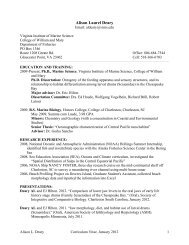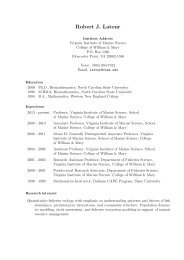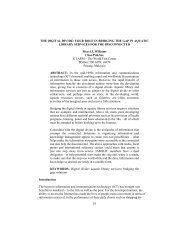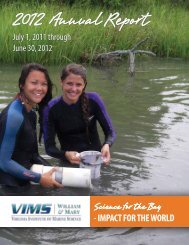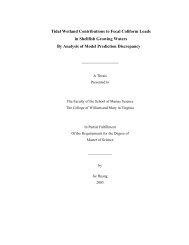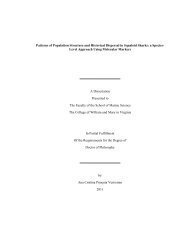68 D. C. Tulipani & M. A. Boudriassity (Boyd, 1962; Longhurst, 1967; Aurioles-Gamboa & Pérez-Flores, 1997), its ecologicalrole in <strong>the</strong> Baja California peninsula coastalwaters and its viability as a productive fishery(Longhurst, 1967; Kato, 1974; Robinson &Gómez-Gutiérrez, 1998).However, little is known about <strong>the</strong> typicalbehaviors <strong>of</strong> P. <strong>planipes</strong>. Kato (1974)briefly described how <strong>the</strong>y swim to <strong>the</strong> surface,change posture to a parachute-shaped pose,and <strong>the</strong>n feed while slowly sinking. This briefdescription leaves some important questionsunanswe<strong>red</strong>: 1) how important are locomotorybehaviors to overall <strong>red</strong> <strong>crab</strong> behavior; and 2)what additional non-locomotory behaviors comprise<strong>the</strong> behavioral repertoire <strong>of</strong> <strong>the</strong> <strong>red</strong> <strong>crab</strong>s?In this study, <strong>the</strong> <strong>red</strong> <strong>crab</strong>s were <strong>observed</strong> in anaquarium to determine <strong>the</strong> typical repertoire <strong>of</strong>behaviors and to develop an activity budget forall locomotory and non-locomotory behaviorsas part <strong>of</strong> an on-going larger study <strong>of</strong> locomotionin this species (Tulipani, 2005).MATERIALS AND METHODSGeneral procedure<strong>Pleuroncodes</strong> <strong>planipes</strong> in captivity wereunder frequent, but not continuous, personalobservation each day. Total observation timefrom June 2001 to September 2003 was approximately800 hours. At any given time overthis period, <strong>the</strong>re were a varying number <strong>of</strong> <strong>red</strong><strong>crab</strong>s, from a few up to 100, in an aquariumat <strong>the</strong> University <strong>of</strong> San Diego. The <strong>crab</strong>s incaptivity were videotaped and photographed atvarious times during <strong>the</strong> study period in support<strong>of</strong> behavior, kinematic, fluid dynamic, andlocomotory behaviors analyses.Specimen collection and careIn June 2001, <strong>the</strong> first group <strong>of</strong> approximately90 P. <strong>planipes</strong> was collected, using alarge dip net, from <strong>the</strong> surface waters at <strong>the</strong>mouth <strong>of</strong> Bahía Magdalena (24º32.89’ N and112º02.63’ W) on <strong>the</strong> southwestern coast <strong>of</strong> <strong>the</strong>Baja California peninsula in Baja CaliforniaSur, Mexico. Fifteen <strong>crab</strong>s were transportedlive to <strong>the</strong> University <strong>of</strong> San Diego via automobile.Ano<strong>the</strong>r group <strong>of</strong> approximately 100<strong>crab</strong>s was collected from various San Diego,California beaches during multiple strandingevents that occur<strong>red</strong> over <strong>the</strong> course <strong>of</strong> nearlythree weeks from <strong>the</strong> end <strong>of</strong> April to early May2002.The <strong>crab</strong>s were kept at <strong>the</strong> University <strong>of</strong> SanDiego in a 250-gallon aquarium with a recirculatingfiltration and cooling system under <strong>the</strong>cycle <strong>of</strong> light (07:00 to 21:00) and dark (21:00to 07:00) periods. In addition to daytime observations,<strong>the</strong> <strong>crab</strong>s were <strong>observed</strong> with <strong>the</strong> aid<strong>of</strong> a flashlight at various times during <strong>the</strong> darkphotoperiod. The retention area <strong>of</strong> <strong>the</strong> aquariumwas approximately 2.5 m (x-axis) long and 66cm wide (y-axis) with <strong>the</strong> water depth (z-axis)approximately 1 m. The water temperature wasmaintained between 15–18ºC. The <strong>crab</strong>s werefed squid once a day and supplemented withphytoplankton and pellet food, with all uneatenfood removed after several hours.Activity budgetFor <strong>the</strong> purpose <strong>of</strong> developing a “typical “or “average” activity budget for <strong>the</strong> <strong>red</strong> <strong>crab</strong>s incaptivity, undisturbed activities <strong>of</strong> a total <strong>of</strong> 30randomly chosen <strong>crab</strong>s were videotaped for 15minutes per <strong>crab</strong>, five <strong>crab</strong>s on each <strong>of</strong> six differentoccasions on 23 May, and 8, 12, 20, 22,and 25 June 2002. Using a 8 mm video cameramodel RCA Pro842 attached to a tripod, behaviorswere recorded twice during morning hours(8:00 am–10:00 am Pacific Daylight-savingsTime (PDT), on 8 and 25 June 2002), twiceduring afternoon hours (1:30 pm–4:30 pm PDT,on 20 and 22 June 2002), and twice duringevening hours (6:00 pm–8:30 pm PDT, on 23May and 12 June 2002). The tapes were eachviewed twice, once to categorize <strong>the</strong> behaviorsand secondly to count <strong>the</strong> number <strong>of</strong> times eachbehavior occur<strong>red</strong>.The behaviors were grouped into two broadcategories: locomotory and stationary, and<strong>the</strong>se were fur<strong>the</strong>r broken into subcategoriesthat were more descriptive. Locomotory behaviorwas defined as that conducted when a <strong>crab</strong>moved from one place to ano<strong>the</strong>r and included:1) swimming (using tail-flips for propulsion)
<strong>Behaviors</strong> <strong>of</strong> <strong>Pleuroncodes</strong> <strong>planipes</strong> 69Fig. 1. Illustration <strong>of</strong> swimming bout by <strong>Pleuroncodes</strong> <strong>planipes</strong>: A) launch from bottom, B) tail-flipswimming, C) breach surface <strong>of</strong> water, D) sink, E) landing on side wall. Illustration by D. Tulipani.(Fig. 1A–C), 2) sinking (Fig. 1D), 3) surfaceswimming pattern (whereby <strong>the</strong> <strong>crab</strong> stays near<strong>the</strong> water’s surface to feed) (Fig. 2A), 4) hovering(<strong>crab</strong> maintains vertical position within <strong>the</strong>water column by using several abbreviated tailflips)(Fig. 2B), 5) walking (Fig. 2D), and 6)climbing (Fig. 2C).Stationary behavior defined as <strong>the</strong> <strong>crab</strong>standing relatively still on a surface was dividedinto three subcategories: 1) interactions withano<strong>the</strong>r <strong>crab</strong>, included a) pushing, b) bumping,c) landing on (Fig. 2F), d) sparring (Fig. 2E),e) tail-flick, and f) antenna flick; 2) “groomingbehavior” was based on which body part wasbeing cleaned and usually entailed <strong>the</strong> scrubbing,rubbing, or wiping <strong>of</strong> <strong>the</strong>se various bodyparts with one (or both) <strong>of</strong> <strong>the</strong> two modifiedfifth pereopods, wiping an eye with both maxillipeds,or by dragging an antenna between <strong>the</strong>maxillipeds; 3) “feeding behavior” was basedon <strong>the</strong> appendage by which food was captu<strong>red</strong>and transfer<strong>red</strong> to <strong>the</strong> mouth region. The abovementionedsubcategories 2) and 3) had mo<strong>red</strong>etailed components based only on <strong>the</strong> greatervariety <strong>of</strong> modes <strong>of</strong> collecting food and areas <strong>of</strong>grooming.Each occurrence <strong>of</strong> behaviors was tallied ona datasheet during <strong>the</strong> 15-minute observationtime for each <strong>crab</strong>. The tallies for each behaviorwere totaled and summarized. Terminology and



